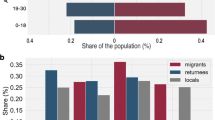Abstract
In this paper, we analyze the demographic factors that influence the migration dynamics of recent immigrants to The Netherlands. We show how we can allow for both permanent and temporary migrants. Results disclose differences among migrants by migration motive and by country of origin and lend support to our analytical framework. Combining both models, for departure and returning to The Netherlands, yields a framework for predicting the migration dynamics over the life-cycle. From the obtained insight in the dynamic composition of migrants in the country, important policy implications can be derived.
Similar content being viewed by others
References
Abbring JH (2002) Stayers versus defecting movers: a note on the identification of defective duration models. Econ Lett 74:327–331
Alders M, Nicolaas H (2003a) Administratieve correcties in de bevolkingsstatistieken (Administrative corrections in the population statistics). Bevolkingstrends 51(4):36–42
Alders M, Nicolaas H (2003b) One in three immigrants leave within six years. CBS Web Magazine, 20 January
Boag JW (1949) Maximum likelihood estimation of the proportion of patients cured by cancer therapy. J R Stat Soc Ser B 11:15–44
Borjas GJ, Bratsberg B (1996) Who leaves? the outmigration of the foreignborn. Rev Econ Stat 78:165–176
CBS (2003) Allochtonen in Nederland 2003. Voorburg
Co CY, Gang IN, Yun MS (2000) Returns to returning. J Popul Econ 13:57–79
Constant A, Massey DS (2003) Self-selection, earnings and out-migration: a longitudinal study of immigrants to Germany. J Popul Econ 16:631–653
Constant A, Zimmermann KF (2003) The dynamics of repeat migration: a Markov chain analysis. Discussion Paper 885, IZA, Bonn
Constant A, Zimmermann KF (2007) Circular migration: counts of exits and years away from the host country. Discussion Paper 2999, IZA, Bonn
Cox DR (1972) Regression models and life–tables (with discussion). J R Stat Soc Ser B 34:187–220
Detang-Dessendre C, Molho I (1999) Migration and changing employment status: a hazard function analysis. J Reg Sci 39:103–123
Dierx AH (1988) A life–cycle model of repeat migration. Reg Sci Urban Econ 18:383–397
Duleep HO (1994) Social security and the emigration of immigrants. Social Secur Bull 57:37–52
Dunsmuir W, Tweedie R, Flack L, Mengersen K (1989) Modelling of transitions between employment states for young Australians. Aust J Stat 31A:165–196
Dustmann C (1995) Return migration: the European experience. Econ Policy 22:214–250
Dustmann C (2000) Temporary migration and economic assimilation. Swed Econ Policy Rev 7:213–244
Dustmann C (2002) Return migration, wage differentials, and the optimal migration duration. Eur Econ Rev 47:353–369
Dustmann C, Weiss Y (2007) Return migration: theory and empirical evidence. Br J Ind Relat 45:236–256
Edin PA, Lalonde RJ, Åslund O (2000) Emigration of immigrants and measures of immigrant assimilation: evidence from Sweden. Swed Econ Rev 7:163–204
Goldstein S (1964) The extend of repeated migration: an analysis based on the Danish population register. J Am Stat Assoc 59:1121–1132
Heckman JJ, Walker JR (1987) Using goodness of fit and other criteria to choose among competing duration models: a case study of Hutterite data. In: Clogg CC (ed) Sociological methodology (1987). American Sociological Association, Washington, DC, pp 247–308
Hill JK (1987) Immigrant decisions concerning durations of stay and migratory frequency. J Dev Econ 25:221–234
Jensen P, Pedersen PJ (2007) To stay or not to stay? out-migration of immigrants from Denmark. Int Migr 45:87–113
Lancaster T (1990) The econometric analysis of transition data. Cambridge University Press, Cambridge
Long LC, Tucker J, Urton WL (1988) Migration distances: an international comparison. Demography 25:633–660
Longva P (2001) Out–migration of immigrants: implications for assimilation analysis. Memorandum 04/2001, University of Oslo
Manton KG, Stallard E, Vaupel JW (1981) Methods for the mortality experience of heterogeous populations. Demography 18:389–410
Massey DS, Espinosa KE (1997) What’s driving Mexico- U.S. migration? a theoretical, empirical and policy analysis. Am J Sociol 102:939–999
Nekby L (2006) The emigration of immigrants, return, vs onward migration: evidence from Sweden. J Popul Econ 19:197–226
Nicolaas H, Sprangers A (2004) Immigrants come and go. CBS Web Magazine, 11 October
Nicolaas H, Sprangers A, Zorlu A, Hartog J (2004) Migranten: wie komen, wie gaan terug en wie laten hun gezin overkomen? (Migrants: Who comes, who returns and who will bring their family?). Bevolkingstrends 52(2):36–42
Reagan PB, Olsen RJ (2000) You can go home again: evidence from longitudinal data. Demography 37:339–350
Schmidt P, Witte AD (1989) Predicting criminal recidivism using ‘split population’ survival time models. J Econom 40:141–159
Van den Berg GJ (2001) Duration models: specification, identification, and multiple duration. In: Heckman JJ, Leamer E (eds) Handbook of econometrics, vol V, Chapter 55. North-Holland, Amsterdam, pp 3381–3460
Van Ours J, Veenman J (2005) The Netherlands; old emigrants—young immigrant country. In: Zimmermann KF (ed) European migration: what do we know? Oxford UP, Oxford, pp 173–196
Zorlu A, Hartog J (2002) Migration and immigrants: the case of The Netherlands. In: Rotte R, Stein P (eds) Migration policy and the economy: international experiences. Hans Seidel Stiftung, Munich, pp 119–140
Zorlu A, Hartog J, Sprangers A, Nicolaas H (2004) Retourmigratiegedrag van recente immigranten (Return migration of recent immigrants). Economische Statistische Berichten (ESB) August 20, 2004 pp 402–404
Author information
Authors and Affiliations
Corresponding author
Additional information
Responsible editor: Klaus F. Zimmermann
Rights and permissions
About this article
Cite this article
Bijwaard, G.E. Immigrant migration dynamics model for The Netherlands. J Popul Econ 23, 1213–1247 (2010). https://doi.org/10.1007/s00148-008-0228-1
Received:
Accepted:
Published:
Issue Date:
DOI: https://doi.org/10.1007/s00148-008-0228-1




